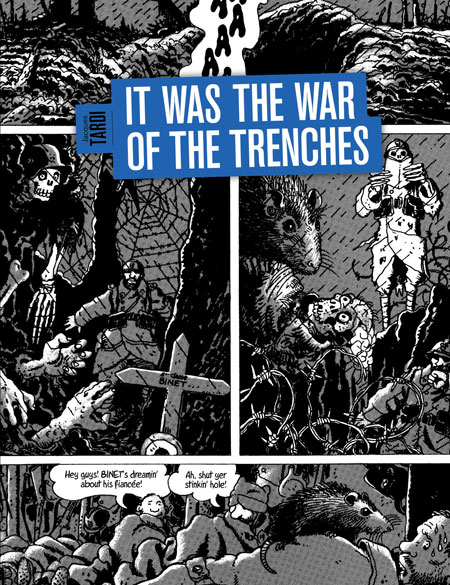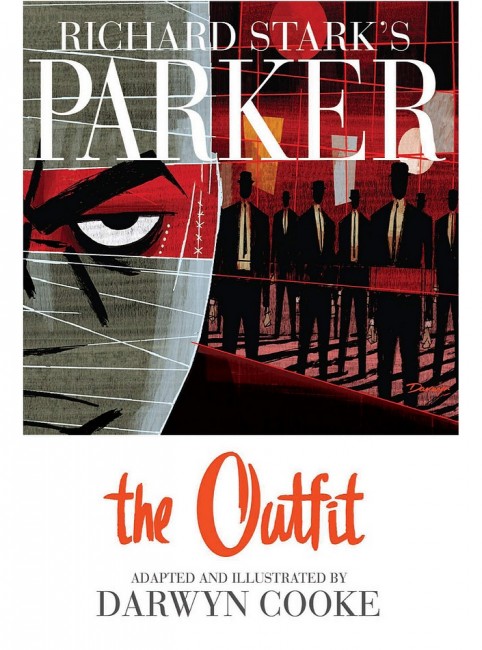
Best of 2010: From My Two Favorite Genres
January 4th, 2011 Posted by david brothers
I’ve liked war comics since I was a kid. My uncle had some Sgt Rocks that I tore through, sometimes literally, and I thought the action was really great. I liked normal people doing things, and being in a military family, it was cool. Not enough about the USAF, I figure, but good enough. Garth Ennis adjusted my view of war comics years later, by focusing on the people, rather than the action.
It Was The War of the Trenches works in that same lane of emotion over action. Tardi delivers several short anecdotes about World War I, with large panels and clean rendering. He’s not doing anything particularly flashy, but he is creating an effective and believable world.
The characters in the book are transient and almost anonymous, with only their names and locations separating them. We get a brief moment to get to know them before being subjected to the horror or inanity of war. Men die screaming for days upon days, others are shot for having human reactions, and still others let themselves become monsters. We don’t see the Germans all that often, but when they do appear, they’re just as normal as the French.
That anonymity works in the book’s favor, particularly in terms of delivering the book’s point about war. You’re left feeling like you just read about the same person experiencing several different events, trapped in a hell not of his own making. It Was the War of the Trenches isn’t as mean as something like Kyle Baker’s Special Forces, which just laid on the sarcasm so thick you can read it as being played perfectly straight. It is, though, a mean book, one with no patience for the ideas of glory in war, a just war, or any war, period. Nobility? Honor? Patriotism? It’s all a joke, and the punchline is dying while trying to hold your own guts in, weeping quietly and asking for your maman.
Tardi depicts war as a faceless meat grinder, one that destroys you and your loved ones regardless of how they feel and who they are. There’s very little in the book that tops the scene where a man who is clearly a vet is battered by a crowd who is angered by his talk of peace. It’s that sort of thing, that willingness to stand behind nationalism and send your boys off to war, that Tardi opens up and dissects. No one’s happy to be in this war. They’re tired, filthy, and sick of dying. And in the end, who wins the war doesn’t matter, because everyone who fought it is dead.

I bought The Outfit the day before New York Comic-Con. I’d intended to read it on the plane, but things didn’t work out. Instead, I read a third of it sitting on the convention floor, the final third elsewhere, and the middle third during one of Marvel’s panels. I’d finished copying down whatever scant news they’d generated and gotten the post ready to go by about halfway through the panel. Corporate panels are mostly boring, though, especially the Q&A parts, so I figured I’d wrap up a book that I was enjoying.
I think I hit the part in the middle, Book Three, while Peter David was talking about some comic I don’t read. And everything tuned out after that, because I was hooked. This is how comics should work. They can take something very simple, like two men robbing a night club or the life of a crime boss, and turn it into something incredible. It doesn’t have to be something with gutters or melodramatic dialogue. The art doesn’t have to stay the same throughout, as long as the shift makes sense thematically.
Cooke shifts styles several times in Book Three. Structured mostly under the concept of “The Lowdown,” a weekly crime mag, Cooke details several heists and they each get their own style. One’s a novel excerpt (positioned as a true crime story) with spot illos. Another looks like a those goofy cartoons where everyone’s face is always facing the camera and grotesque. Styles upon styles upon styles is what he has.
The contrast between what I was reading and the announcements I’d just written down for Marvel were striking. The Outfit is based on a novel that’s over forty years old, but it was full of old ideas made fresh and clean. The experimentation in format took those ideas and fired them at your face, rocketing off the pages at escape velocity. Mean, vicious, and undeniable.
The Outfit isn’t a graphic novel. It’s not even just a good story, another solid graphic novel from a guy who already has more quality under his belt than most people get. It’s a classroom. It’s a lesson in storytelling, in how to put together a comic, and how far you can stretch the formula before it isn’t a comic any more.
Here’s the answer: it will always be a comic. Comics can do anything. All you have to do is stretch.
